Traceability Research on Dendrobium devonianum Based on SWATHtoMRM
Abstract
1. Introduction
2. Materials and Methods
2.1. Sample Collection and Preparation
2.2. Chemicals and Reagents
2.3. Sample Preparation and Analysis
2.3.1. Sample Preparation and Instrumental Method
2.3.2. MRM Data Collection
2.3.3. Data Processing and Statistical Analysis
3. Results
3.1. Analytical Characteristics of SWATHtoMRM Method
3.2. MRM Data Analysis
3.3. ANOVA, FDR, and VIP Analysis
3.4. Structural Identification of Characteristic Compounds
3.5. KEGG Pathway Analysis of Dendrobium devonianum and Dendrobium officinale
4. Conclusions
Supplementary Materials
Author Contributions
Funding
Data Availability Statement
Conflicts of Interest
References
- Wu, B.-L.; Zhao, Z.-R.; Liu, H.; Jiao, D.; Wu, Y.-G. Research progress of Dendrobium devonianum. Chin. Tradit. Pat. Med. 2020, 42, 2990–2998. [Google Scholar]
- Wu, L.-L.; Ding, Y.-L.; Xie, Y.-F.; Chen, D.-Q.; Xu, H. Research on bibenzyl constituents and TLC identification of the stem of Dendrobium devoninum. Northwest Pharm. J. 2020, 35, 791–795. [Google Scholar]
- Available online: http://www.pbh.yn.gov.cn/wjwWebsite/web/doc/UU151669310662159294 (accessed on 7 July 2023).
- Zhan, R.; Zhang, X.-Y.; Li, Z.-Y.; Liu, B.; Chen, Y.-G. Immunosuppressive bibenzyl-phenylpropane hybrids from Dendrobium devonianum. Chem. Biodivers. 2023, 20, e202201185. [Google Scholar] [CrossRef]
- Li, J.; Zhang, X.; Li, Y.; Liu, B.; Zhan, R. Bibenzyls and lignans from Dendrobium devonianum and their immunosuppressive activities. Phytochem. Lett. 2023, 54, 137–140. [Google Scholar] [CrossRef]
- Geographical Indication Products-Dendrobium devonianum from Longling; Yunnan Provincial Bureau of Quality and Technical Supervision: Baoshan, China, 2014.
- Lin, T.; Chen, X.-L.; Wang, J.; Hu, Z.-X.; Wu, G.-W.; Sha, L.-J.; Cheng, L.; Liu, H.-C. Application of time of flight mass spectrometry in the identification of Dendrobium devonianum Paxt and Dendrobium officinale Kimura et Migo Grown in Longling Area of Yunnan, China. Separations 2022, 9, 108. [Google Scholar] [CrossRef]
- Dou, X.; Zhang, L.; Yang, R.; Wang, X.; Yu, L.; Yue, X.; Ma, F.; Mao, J.; Wang, X.; Zhang, W.; et al. Mass spectrometry in food authentication and origin traceability. Mass Spectrom. Rev. 2022, 42, 1772–1807. [Google Scholar] [CrossRef]
- Li, Q.; Yang, S.; Li, B.; Zhang, C.; Li, Y.; Li, J. Exploring critical metabolites of honey peach (Prunus persica (L.) Batsch) from five main cultivation regions in the north of China by UPLC-Q-TOF/MS combined with chemometrics and modeling. Food Res. Int. 2022, 157, 111213. [Google Scholar] [CrossRef]
- Liu, X.; Zhong, C.; Xie, J.; Liu, H.; Xie, Z.; Zhang, S.; Jin, J. Geographical region traceability of Poria cocos and correlation between environmental factors and biomarkers based on a metabolomic approach. Food Chem. 2023, 417, 135817. [Google Scholar] [CrossRef]
- Ye, Z.; Dai, J.-R.; Zhang, C.-G.; Lu, Y.; Wu, L.-L.; Gong, A.G.W.; Xu, H.; Tsim, K.W.K.; Wang, Z.-T. Chemical differentiation of Dendrobium officinale and Dendrobium devonianum by using HPLC fingerprints, HPLC-ESI-MS, and HPTLC analyses. Evid.-Based Complement Alternat. Med. 2017, 2017, 8647212. [Google Scholar] [CrossRef]
- Lin, T.; Chen, X.-L.; Wu, G.-W.; Sha, L.-J.; Wang, J.; Hu, Z.-X.; Liu, H.-C. A simple method for distinguishing Dendrobium devonianum and Dendrobium officinale by ultra performance liquid chromatography-photo diode array detector. Food Sci. Technol. 2023, 43, e110122. [Google Scholar] [CrossRef]
- Simonnet-Laprade, C.; Bayen, S.; McGoldrick, D.; McDaniel, T.; Hutinet, S.; Marchand, P.; Vénisseau, A.; Cariou, R.; Le Bizec, B.; Dervilly, G.J.C. Evidence of complementarity between targeted and non-targeted analysis based on liquid and gas-phase chromatography coupled to mass spectrometry for screening halogenated persistent organic pollutants in environmental matrices. Chemosphere 2022, 293, 133615. [Google Scholar] [CrossRef]
- Crimmins, B.S.; Holsen, T.M. Non-targeted screening in environmental monitoring programs. In Advancements of Mass Spectrometry in Biomedical Research; Woods, A.G., Darie, C.C., Eds.; Springer International Publishing: Cham, Switzerland, 2019; pp. 731–741. [Google Scholar]
- Martínez-Bueno, M.; Ramos, M.G.; Bauer, A.; Fernández-Alba, A. An overview of non-targeted screening strategies based on high resolution accurate mass spectrometry for the identification of migrants coming from plastic food packaging materials. TrAC Trends Anal. Chem. 2019, 110, 191–203. [Google Scholar] [CrossRef]
- Zha, H.; Cai, Y.; Yin, Y.; Wang, Z.; Li, K.; Zhu, Z.-J. SWATHtoMRM: Development of high-coverage targeted metabolomics method using SWATH technology for biomarker discovery. Anal. Chem. 2018, 90, 4062–4070. [Google Scholar] [CrossRef]
- Song, J.; Wang, X.; Guo, Y.; Yang, Y.; Xu, K.; Wang, T.; Sa, Y.; Yuan, L.; Jiang, H.; Guo, J. Novel high-coverage targeted metabolomics method (SWATHtoMRM) for exploring follicular fluid metabolome alterations in women with recurrent spontaneous abortion undergoing in vitro fertilization. Sci. Rep. 2019, 9, 10873. [Google Scholar] [CrossRef]
- Xu, L.; Xu, Z.; Wang, X.; Wang, B.; Liao, X. The application of pseudotargeted metabolomics method for fruit juices discrimination. Food Chem. 2020, 316, 126278. [Google Scholar] [CrossRef]
- Song, J.; Xiang, S.; Pang, C.; Guo, J.; Sun, Z. Metabolomic alternations of follicular fluid of obese women undergoing in-vitro fertilization treatment. Sci. Rep. 2020, 10, 5968. [Google Scholar] [CrossRef]
- Tao, Z.; Lu, N.; Wu, X.; Huang, Y.; Xiao, Y.; Wang, X. Research progress on chemical constituents and pharmacological action of Dendrobium. J. Pharm. Res. 2021, 40, 44–51+70. [Google Scholar]
- Rao, D.; Zhao, R.; Hu, Y.; Li, H.; Chun, Z.; Zheng, S. Revealing of intracellular antioxidants in Dendrobium nobile by high performance liquid chromatography-tandem mass spectrometry. Metabolites 2023, 13, 702. [Google Scholar] [CrossRef]
- He, C.; Peng, C.; Dai, O.; Yang, L.; Liu, J.; Guo, L.; Xiong, L.; Liu, Z. Chemical constituents from Leonurus japonicus Injection. Chin. Tradit. Herb. Drugs 2014, 45, 3048–3052. [Google Scholar]
- Zhang, J.; Xu, H.-X.; Zhao, Z.-L.; Xian, Y.-F.; Lin, Z.-X. Dendrobium nobile Lindl: A review on its chemical constituents and pharmacological effects. Chin. Med. Cult. 2021, 4, 235–242. [Google Scholar] [CrossRef]
- Horton, D.; Rodemeyer, G.; Haskell, T.H. Analytical characterization of lipopolysaccharide antigens from seven strains of Pseudomonas aeruginosa. Carbohydr. Res. 1977, 55, 35–47. [Google Scholar] [CrossRef]
- Chen, W.; Yeo, S.C.M.; Chuang, X.F.; Lin, H.-S. Determination of pinostilbene in rat plasma by LC–MS/MS: Application to a pharmacokinetic study. J. Pharm. Biomed. Anal. 2016, 120, 316–321. [Google Scholar] [CrossRef]
- Kato, Y.; Terada, H. Determination method of linamarin in cassava products and beans by ultra high performance liquid chromatography with tandem mass spectrometry. Shokuhin Eiseigaku Zasshi J. Food Hyg. Soc. Jpn. 2014, 55, 162–166. [Google Scholar] [CrossRef]
- Yang, X.-B.; Yan, S.; Hu, J.-M.; Zhou, J. Chemical constituents from Dendrobium heterocarpum Lindl. Nat. Prod. Res. Dev. 2019, 31, 1745–1752. [Google Scholar]
- Song, C.; Zhang, Y.; Manzoor, M.A.; Li, G. Identification of alkaloids and related intermediates of Dendrobium officinale by solid-phase extraction coupled with high-performance liquid chromatography tandem mass spectrometry. Front. Plant Sci. 2022, 13, 952051. [Google Scholar] [CrossRef]
- Ma, Y.; Li, P.; Chen, D.; Fang, T.; Li, H.; Su, W. LC/MS/MS quantitation assay for pharmacokinetics of naringenin and double peaks phenomenon in rats plasma. Int. J. Pharm. 2006, 307, 292–299. [Google Scholar] [CrossRef]
- Katsumata, S.; Hamana, K.; Horie, K.; Toshima, H.; Hasegawa, M. Identification of sternbin and naringenin as detoxified metabolites from the rice flavanone phytoalexin sakuranetin by pyricularia oryzae. Chem. Biodivers. 2017, 14, e1600240. [Google Scholar] [CrossRef]
- Bulama, J.; Dangoggo, S.; Halilu, M.; Tsafe, A.; Hassan, S. Isolation and characterization of palmitic acid from ethyl acetate extract of root bark of Terminalia glaucescens. Chem. Mater. Res. 2014, 6, 140–143. [Google Scholar]
- Ye, Q.; Zhao, W. New alloaromadendrane, cadinene and cyclocopacamphane type sesquiterpene derivatives and bibenzyls from Dendrobium nobile. Planta Medica 2002, 68, 723–729. [Google Scholar] [CrossRef]
- Zhu, Y.; Feng, Y.; Shen, L.; Xu, D.; Wang, B.; Ruan, K.; Cong, W. Effect of metformin on the urinary metabolites of diet-induced-obese mice studied by ultra performance liquid chromatography coupled to time-of-flight mass spectrometry (UPLC-TOF/MS). J. Chromatogr. B 2013, 925, 110–116. [Google Scholar] [CrossRef]
- Wei, M.; Liu, Z.; Liu, Y.; Li, S.; Hu, M.; Yue, K.; Liu, T.; He, Y.; Pi, Z.; Liu, Z.; et al. Urinary and plasmatic metabolomics strategy to explore the holistic mechanism of lignans in S. chinensis in treating Alzheimer’s disease using UPLC-Q-TOF-MS. Food Funct. 2019, 10, 5656–5668. [Google Scholar] [CrossRef] [PubMed]
- Yang, J.; Han, X.; Wang, H.-Y.; Yang, J.; Kuang, Y.; Ji, K.-Y.; Yang, Y.; Pang, K.; Yang, S.-X.; Qin, J.-C.; et al. Comparison of metabolomics of Dendrobium officinale in different habitats by UPLC-Q-TOF-MS. Biochem. Syst. Ecol. 2020, 89, 104007. [Google Scholar] [CrossRef]
- Wu, D.; Li, X.; Zhang, X.; Han, F.; Lu, X.; Liu, L.; Zhang, J.; Dong, M.; Yang, H.; Li, H. Pharmacometabolomics Identifies 3-Hydroxyadipic Acid, d-Galactose, Lysophosphatidylcholine (P-16:0), and Tetradecenoyl-l-Carnitine as Potential Predictive Indicators of Gemcitabine Efficacy in Pancreatic Cancer Patients. Front. Oncol. 2020, 9, 1524. [Google Scholar] [CrossRef]
- Lu, X.; Zhang, X.; Zhang, Y.; Zhang, K.; Zhan, C.; Shi, X.; Li, Y.; Zhao, J.; Bai, Y.; Wang, Y.; et al. Metabolic profiling analysis upon acylcarnitines in tissues of hepatocellular carcinoma revealed the inhibited carnitine shuttle system caused by the downregulated carnitine palmitoyltransferase 2. Mol. Carcinog. 2019, 58, 749–759. [Google Scholar] [CrossRef]
- Zhao, W.; Ye, Q.; Tan, X.; Jiang, H.; Li, X.; Chen, K.; Kinghorn, A.D. Three New Sesquiterpene Glycosides from Dendrobium nobile with Immunomodulatory Activity. J. Nat. Prod. 2001, 64, 1196–1200. [Google Scholar] [CrossRef]
- Yang, W.; Kong, L.; Zhang, Y.; Tang, G.; Zhu, F.; Li, S.; Guo, L.; Cheng, Y.; Hao, X.; He, H. Phragmalin-type Limonoids from Heynea trijuga. Planta Med. 2012, 78, 1676–1682. [Google Scholar] [CrossRef]
- Zhao, D.; Xie, L.; Yu, L.; An, N.; Na, W.; Chen, F.; Li, Y.; Tan, Y.; Zhang, X. New 2-Benzoxazolinone Derivatives with Cytotoxic Activities from the Roots of Acanthus Ilicifolius Chem. Pharm. Bull. 2015, 63, 1087–1090. [Google Scholar] [CrossRef]
- Xiang, Y.; Li, Y.-B.; Zhang, J.; Li, P.; Yao, Y.-z. Studies on chemical constituents of Salsola collina. China J. Chin. Mater. Medica 2007, 32, 409–413. [Google Scholar]
- Avula, B.; Wang, Y.-H.; Smillie, T.J.; Khan, I.A. Determination of Shikimic Acid in Fruits of Illicium Species and Various Other Plant Samples by LC–UV and LC–ESI–MS. Chromatographia 2009, 69, 307–314. [Google Scholar] [CrossRef]
- Zhuang, B.; Bi, Z.-M.; Wang, Z.-Y.; Duan, L.; Lai, C.-J.-S.; Liu, E.H. Chemical profiling and quantitation of bioactive compounds in Platycladi Cacumen by UPLC-Q-TOF-MS/MS and UPLC-DAD. J. Pharm. Biomed. Anal. 2018, 154, 207–215. [Google Scholar] [CrossRef]
- Wu, C.; Wang, J.; Zhang, C.; Wang, D.; Zhang, L.; Cao, M.; Wang, Y.; Li, Q. Determination of Four Sugars in Infant Formula Milk Powder and Dairy Products by Ion Chromatography-Mass Spectrometry. Food Sci. Technol. 2020, 45, 264–268. [Google Scholar]
- Lan, Y.; Zhang, J.; Ll, O.; Feng, J. Determination of Three Monosaccharides in Dendrobium denneanum and D.officinale by UPLC-QQQ-MS. Guangzhou Chem. Ind. 2022, 50, 143–145. [Google Scholar]
- Chen, Y.; Yu, H.; Lian, X. Isolation of stilbenoids and lignans from Dendrobium hongdie. Trop. J. Pharm. Res. 2015, 14, 2055–2059. [Google Scholar] [CrossRef][Green Version]
- Yang, L.; Wang, Y.; Zhang, G.; Zhang, F.; Zhang, Z.; Wang, Z.; Xu, L. Simultaneous quantitative and qualitative analysis of bioactive phenols in Dendrobium aurantiacum var. denneanum by high-performance liquid chromatography coupled with mass spectrometry and diode array detection. Biomed. Chromatogr. 2007, 21, 687–694. [Google Scholar] [CrossRef] [PubMed]
- Zhu, A.-L.; Hao, J.-W.; Liu, L.; Wang, Q.; Chen, N.-D.; Wang, G.-L.; Liu, X.-Q.; Li, Q.; Xu, H.-M.; Yang, W.-H. Simultaneous Quantification of 11 Phenolic Compounds and Consistency Evaluation in Four Dendrobium Species Used as Ingredients of the Traditional Chinese Medicine Shihu. Front. Nutr. 2021, 8, 771078. [Google Scholar] [CrossRef] [PubMed]
- Wang, Y.; Han, B.; Li, Z.; Nie, X.; Yang, M.; Wang, W.; Sun, Z. Determination of the Compounds of Dendrobium pendulum Roxb. by UPLC-Q-TOF-MS. Chin. Pharm. J. 2021, 56, 708–714. [Google Scholar]
- Tezuka, Y.; Hirano, H.; Kikuchi, T.; Xu, G.-J. Constituents of Ephemerantha lonchophylla; isolation and structure elucidation of new phenolic compounds, ephemeranthol-A, ephemeranthol-B, and ephemeranthoquinone, and of a new diterpene glucoside, ephemeranthoside. Chem. Pharm. Bull. 1991, 39, 593–598. [Google Scholar] [CrossRef]
- Yang, H.; Gong, Y.; Wang, Z.; Xu, L.; Hu, Z.; Xu, G. Studies on chemical constituents of Dendrobium chrysotoxum. Chin. Tradit. Herb. Drugs 2001, 32, 972–974. [Google Scholar]
- Kaganda, N.; Adesanya, S. A new dihydrostilbene from diseased Dioscorea mangenotiana. J. Nat. Prod. 1990, 53, 1345–1346. [Google Scholar] [CrossRef]
- Li, Y.; Wang, C.-L.; Guo, S.-X.; Yang, J.-S.; Xiao, P.-G. Two new compounds from Dendrobium candidum. Chem. Pharm. Bull. 2008, 56, 1477–1479. [Google Scholar] [CrossRef]
- Okamoto, T.; Natsume, M.; Onaka, T.; Uchimaru, F.; Shimizu, M. The structure of dendroxine the third alkaloid from Dendrobium nobile. Chem. Pharm. Bull. 1966, 14, 672–675. [Google Scholar] [CrossRef] [PubMed]
- Wang, Y.-H.; Avula, B.; Abe, N.; Wei, F.; Wang, M.; Ma, S.-C.; Ali, Z.; Elsohly, M.A.; Khan, I.A. Tandem Mass Spectrometry for Structural Identification of Sesquiterpene Alkaloids from the Stems of Dendrobium nobile Using LC-QToF. Planta Medica 2016, 82, 662–670. [Google Scholar] [CrossRef] [PubMed]
- Nagai, T.; Kiyohara, H.; Munakata, K.; Shirahata, T.; Sunazuka, T.; Harigaya, Y.; Yamada, H. Pinellic acid from the tuber of Pinellia ternata Breitenbach as an effective oral adjuvant for nasal influenza vaccine. Int. Immunopharmacol. 2002, 2, 1183–1193. [Google Scholar] [CrossRef]
- Cong, W.; Schwartz, E.; Peterson, D.G. Identification of inhibitors of pinellic acid generation in whole wheat bread. Food Chem. 2021, 351, 129291. [Google Scholar] [CrossRef]
- Fujimoto, T.; Oku, K.; Tashiro, M.; Machinami, T. Crystal Structure of α,α-Trehalose–Calcium Chloride Monohydrate Complex. J. Carbohydr. Chem. 2006, 25, 521–532. [Google Scholar] [CrossRef]
- Tan, D.; Song, Y.; Wang, J.; Gao, C.; Qin, L.; Zhao, Y.; Lu, Y.; Yang, Z.; He, Y. Identification of sesquiterpene glycosides from Dendrobium nobile and their α-glycosidase and α-amylase inhibitory activities. Food Sci. Technol. 2022, 43, e99722. [Google Scholar] [CrossRef]
- Ye, Q.; Qin, G.; Zhao, W. Immunomodulatory sesquiterpene glycosides from Dendrobium nobile. Phytochemistry 2002, 61, 885–890. [Google Scholar] [CrossRef]
- Zhao, C.; Liu, Q.; Halaweish, F.; Shao, B.; Ye, Y.; Zhao, W. Copacamphane, Picrotoxane, and Alloaromadendrane Sesquiterpene Glycosides and Phenolic Glycosides from Dendrobium moniliforme. J. Nat. Prod. 2003, 66, 1140–1143. [Google Scholar] [CrossRef]
- Lijina, P.; Gnanesh Kumar, B.S. Discrimination of raffinose and planteose based on porous graphitic carbon chromatography in combination with mass spectrometry. J. Chromatogr. B 2023, 1224, 123758. [Google Scholar] [CrossRef]
- Huang, Y.P.; Robinson, R.C.; Barile, D. Food glycomics: Dealing with unexpected degradation of oligosaccharides during sample preparation and analysis. J. Food Drug Anal. 2022, 30, 62–76. [Google Scholar] [CrossRef]
- Han, J.; Ye, M.; Qiao, X.; Xu, M.; Wang, B.-R.; Guo, D.-A. Characterization of phenolic compounds in the Chinese herbal drug Artemisia annua by liquid chromatography coupled to electrospray ionization mass spectrometry. J. Pharm. Biomed. Anal. 2008, 47, 516–525. [Google Scholar] [CrossRef] [PubMed]
- Silva, D.B.; Turatti, I.C.C.; Gouveia, D.R.; Ernst, M.; Teixeira, S.P.; Lopes, N.P. Mass Spectrometry of Flavonoid Vicenin-2, Based Sunlight Barriers in Lychnophora species. Sci. Rep. 2014, 4, 4309. [Google Scholar] [CrossRef] [PubMed]
- Yang, J.; Qian, D.; Jiang, S.; Shang, E.-X.; Guo, J.; Duan, J.-A. Identification of rutin deglycosylated metabolites produced by human intestinal bacteria using UPLC–Q-TOF/MS. J. Chromatogr. B 2012, 898, 95–100. [Google Scholar] [CrossRef] [PubMed]
- Oskouei, Z.; Rahbardar, M.G.; Hosseinzadeh, H. The effects of Dendrobium species on the metabolic syndrome: A review. Iran. J. Basic Med. Sci. 2023, 26, 738. [Google Scholar] [PubMed]
- Zhou, X.; Wang, X.; Sun, Q.; Zhang, W.; Liu, C.; Ma, W.; Sun, C. Natural compounds: A new perspective on targeting polarization and infiltration of tumor-associated macrophages in lung cancer. Biomed. Pharmacother. 2022, 151, 113096. [Google Scholar] [CrossRef]
- Inthongkaew, P.; Chatsumpun, N.; Supasuteekul, C.; Kitisripanya, T.; Putalun, W.; Likhitwitayawuid, K.; Sritularak, B. α-Glucosidase and pancreatic lipase inhibitory activities and glucose uptake stimulatory effect of phenolic compounds from Dendrobium formosum. Rev. Bras. Farmacogn. 2017, 27, 480–487. [Google Scholar] [CrossRef]


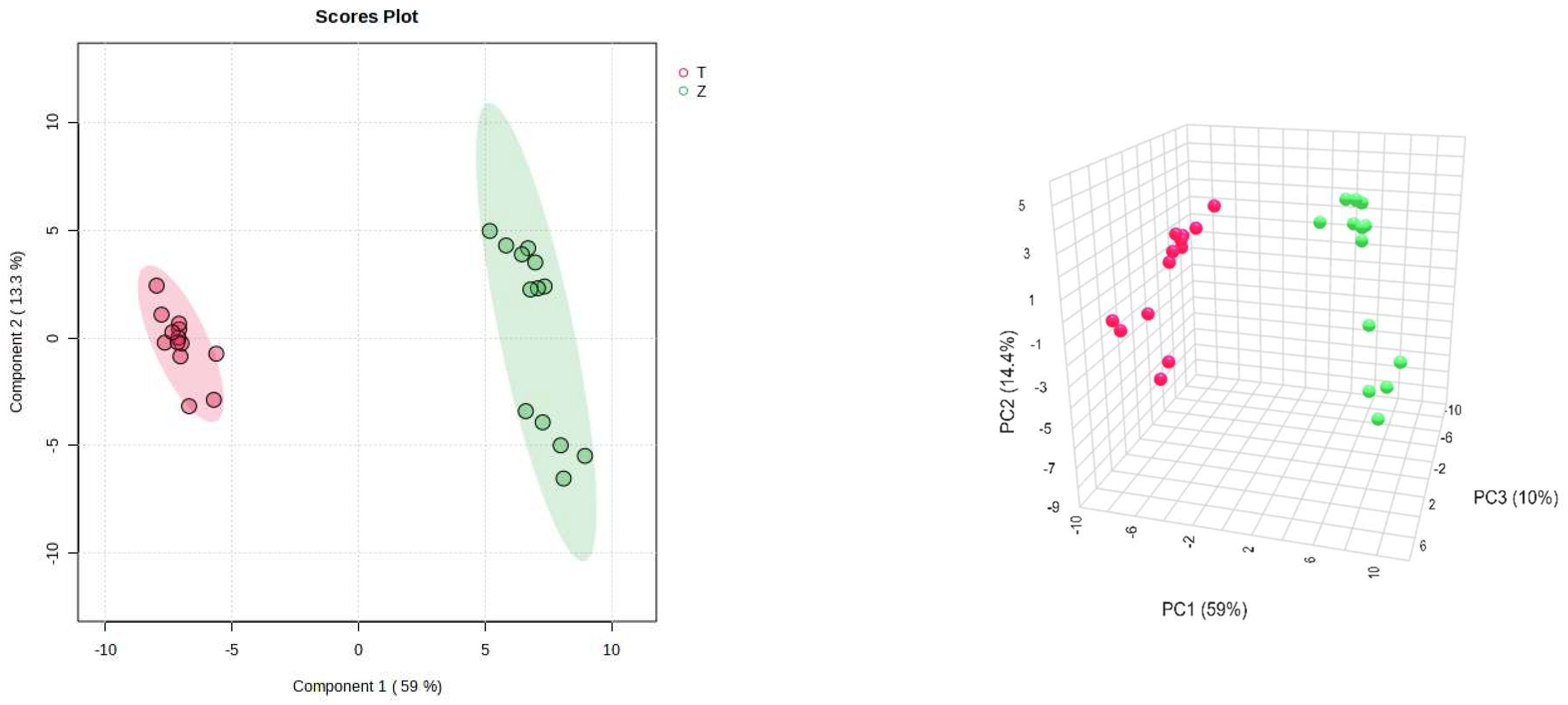
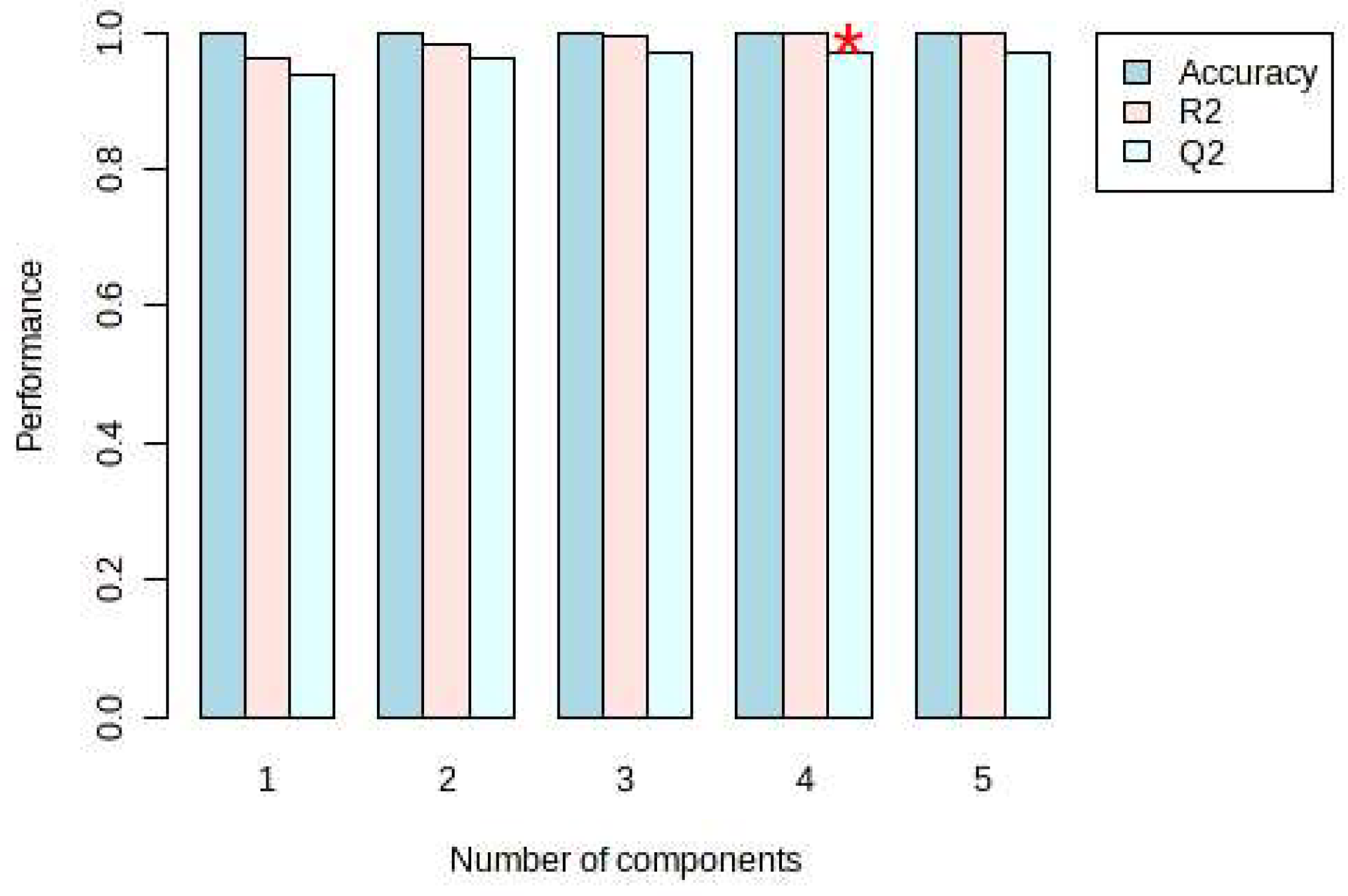


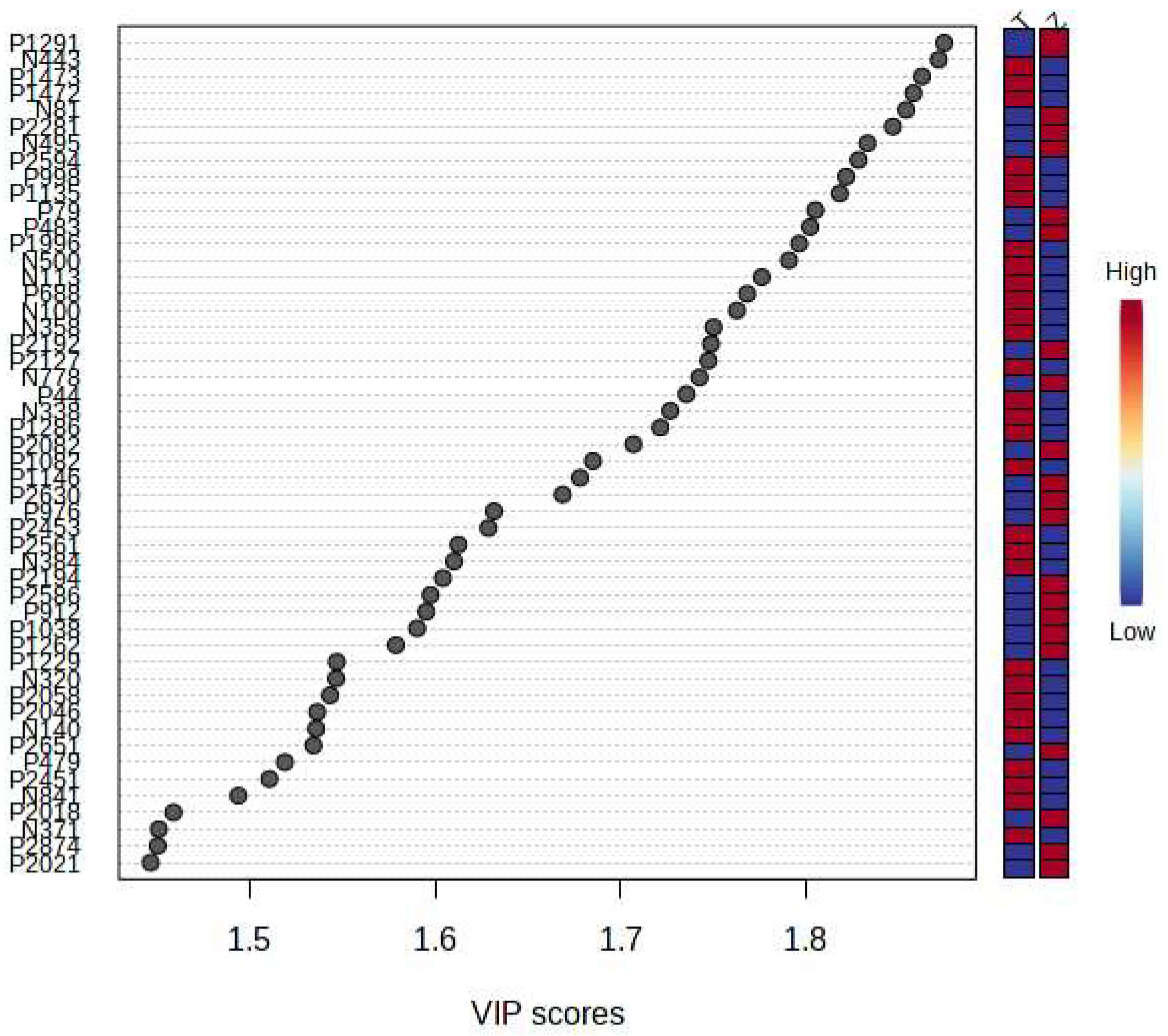
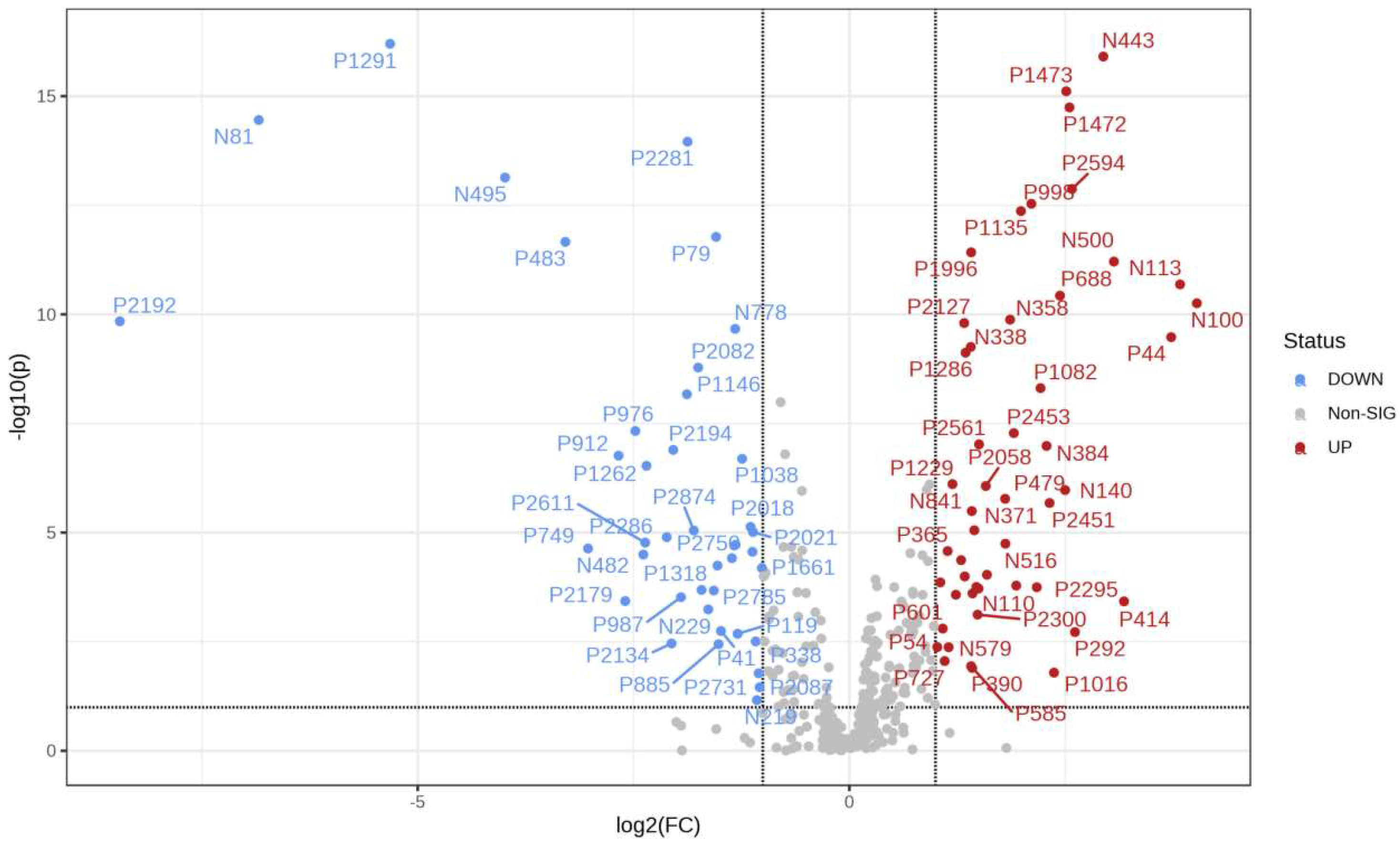
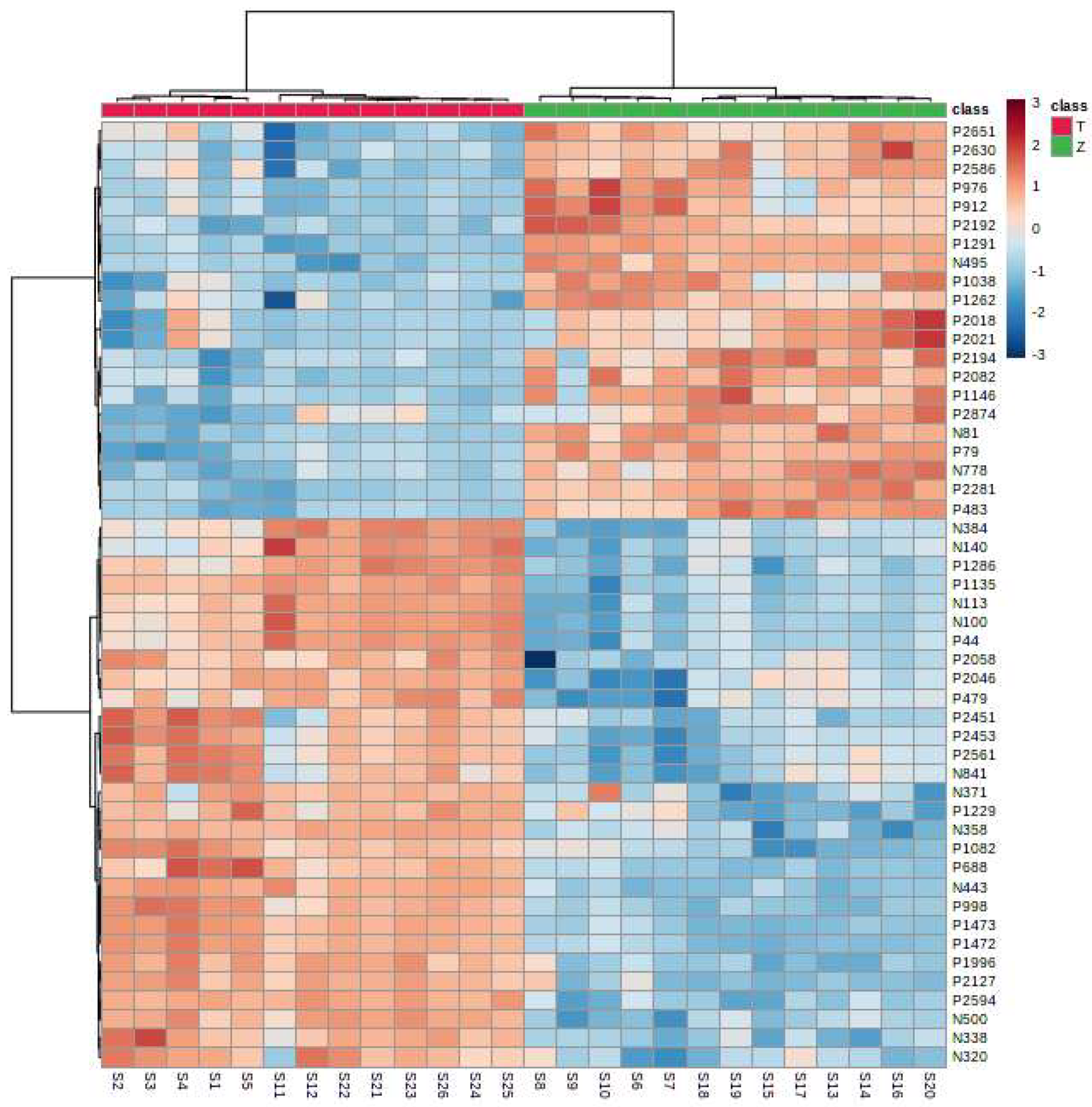
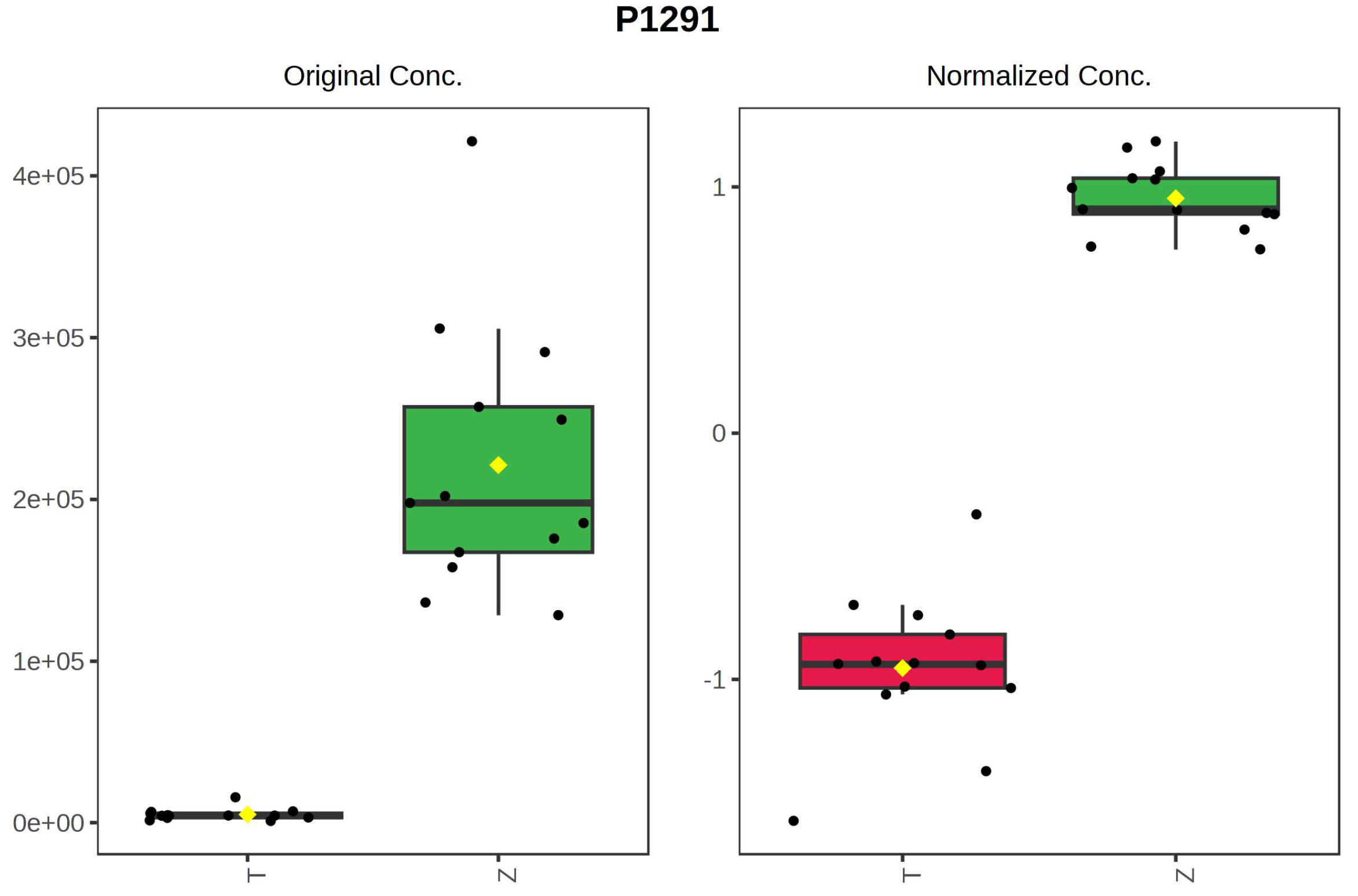
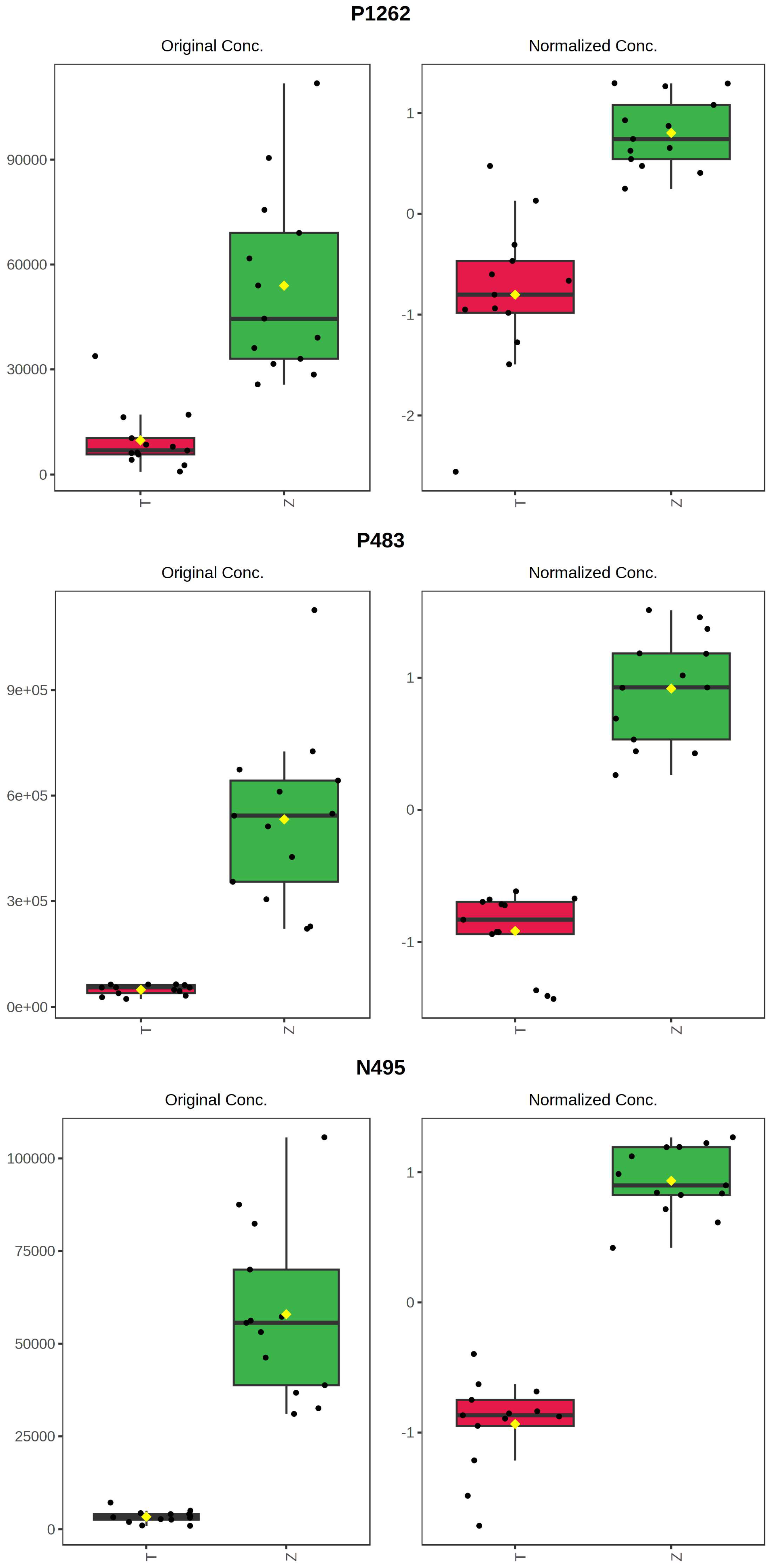
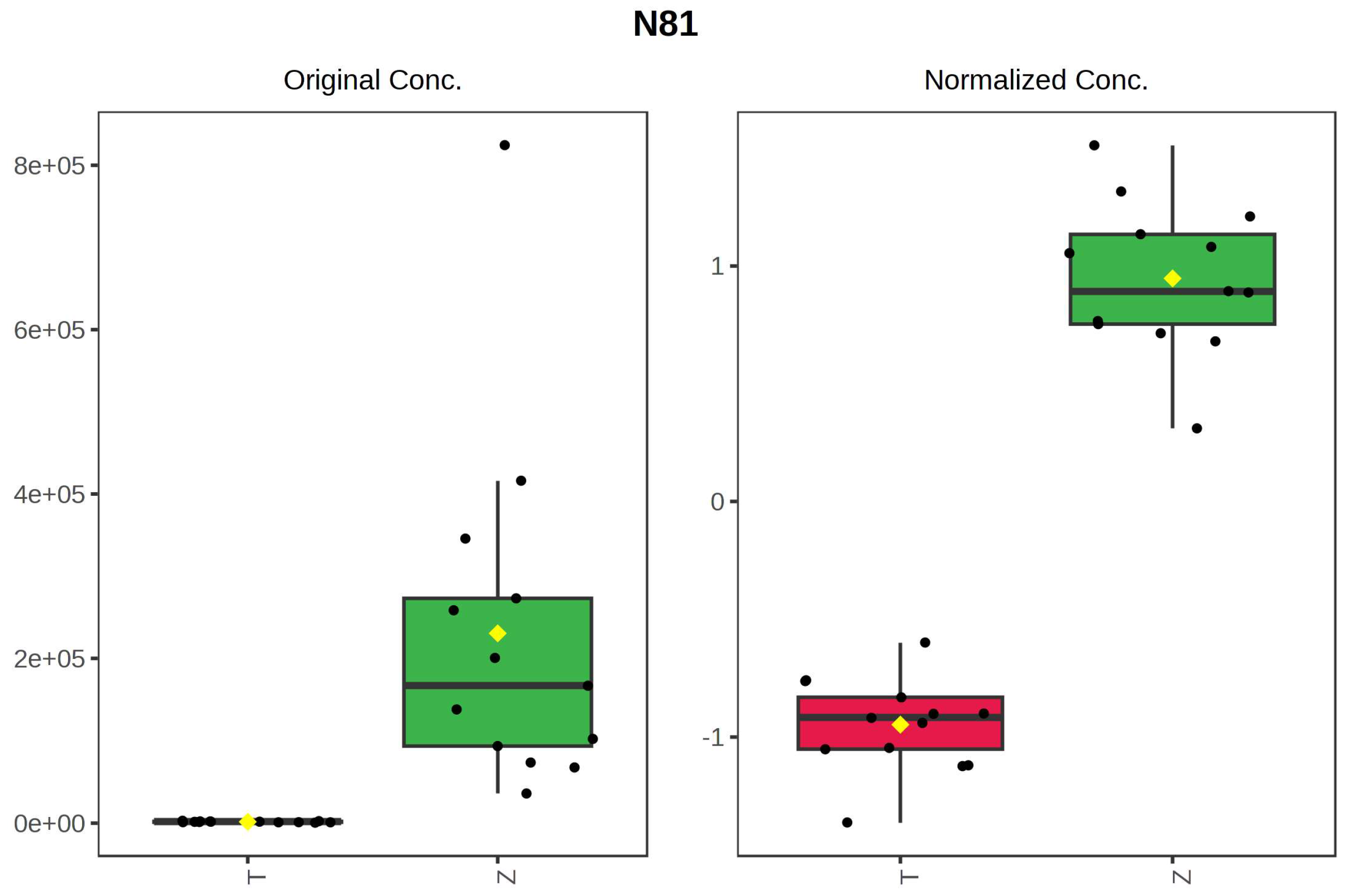

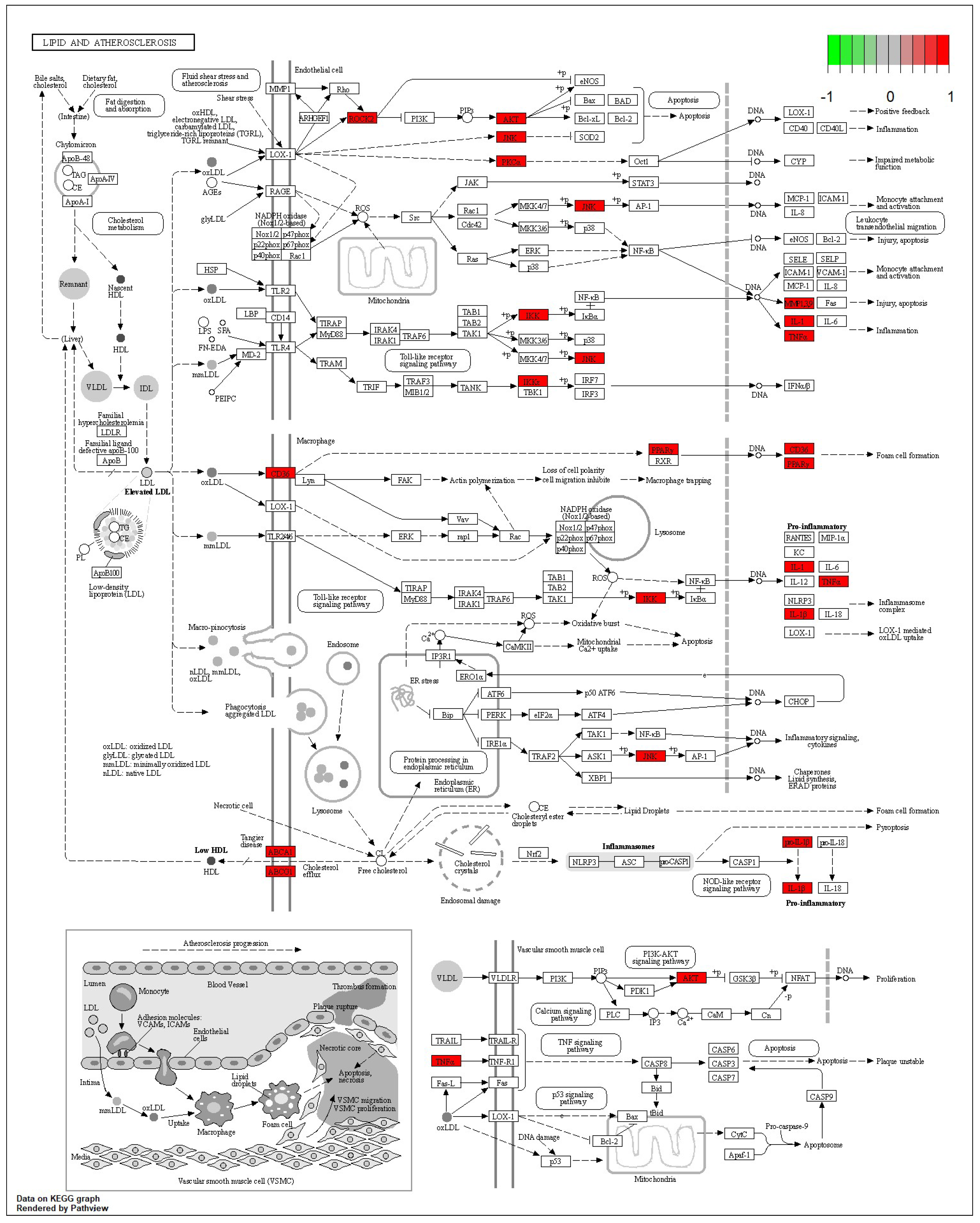
| Compound Code | Precursor Ion (m/z) | Product Ion (m/z) | Retention Time (min) | p Value | FDR | VIP | Changes in Content | |
|---|---|---|---|---|---|---|---|---|
| Dendrobium devonianum | Dendrobium officinale | |||||||
| P1291 | 438.2390 | 70.0651 | 6.60 | 6.32 × 10−17 | 2.20 × 10−14 | 1.8749 | ↑ | ↓ |
| N443 | 533.1296 | 124.9909 | 6.64 | 1.24 × 10−16 | 2.20 × 10−14 | 1.8719 | ↓ | ↑ |
| P1473 | 476.2134 | 137.0597 | 6.90 | 7.73 × 10−16 | 9.17 × 10−14 | 1.8630 | ↓ | ↑ |
| P1472 | 476.1928 | 137.0236 | 6.67 | 1.81 × 10−15 | 1.61 × 10−13 | 1.8583 | ↓ | ↑ |
| N81 | 239.0707 | 196.0524 | 7.79 | 3.52 × 10−15 | 2.50 × 10−13 | 1.8544 | ↓ | ↑ |
| P2281 | 682.5257 | 248.2375 | 15.73 | 1.11 × 10−14 | 6.57 × 10−13 | 1.8472 | ↑ | ↓ |
| N495 | 609.1449 | 311.0557 | 6.66 | 7.31 × 10−14 | 3.72 × 10−12 | 1.8335 | ↑ | ↓ |
| P2594 | 811.6109 | 235.0970 | 6.69 | 1.34 × 10−13 | 5.97 × 10−12 | 1.8287 | ↓ | ↑ |
| P998 | 374.1813 | 154.0624 | 7.00 | 2.92 × 10−13 | 1.16 × 10−11 | 1.8220 | ↓ | ↑ |
| P1135 | 401.1601 | 167.0706 | 6.93 | 4.30 × 10−13 | 1.53 × 10−11 | 1.8185 | ↓ | ↑ |
| P79 | 144.1019 | 70.0650 | 0.73 | 1.68 × 10−12 | 5.43 × 10−11 | 1.8053 | ↑ | ↓ |
| P483 | 272.2222 | 105.0698 | 7.66 | 2.19 × 10−12 | 6.49 × 10−11 | 1.8026 | ↑ | ↓ |
| P1996 | 613.2288 | 167.0703 | 6.99 | 3.79 × 10−12 | 1.04 × 10−10 | 1.7966 | ↓ | ↑ |
| N500 | 614.2169 | 61.9883 | 5.61 | 6.18 × 10−12 | 1.57 × 10−10 | 1.7911 | ↓ | ↑ |
| N113 | 273.1128 | 137.0238 | 7.68 | 2.06 × 10−11 | 4.89 × 10−10 | 1.7764 | ↓ | ↑ |
| P688 | 315.9915 | 119.0186 | 0.56 | 3.73 × 10−11 | 8.29 × 10−10 | 1.7686 | ↓ | ↑ |
| N100 | 271.0969 | 213.0553 | 8.07 | 5.57 × 10−11 | 1.17 × 10−9 | 1.7630 | ↓ | ↑ |
| N358 | 459.1506 | 149.0598 | 6.94 | 1.32 × 10−10 | 2.61 × 10−9 | 1.7504 | ↓ | ↑ |
| P2192 | 665.1730 | 271.0600 | 6.80 | 1.44 × 10−10 | 2.71 × 10−9 | 1.7490 | ↑ | ↓ |
| P2127 | 643.2394 | 167.0702 | 6.97 | 1.58 × 10−10 | 2.82 × 10−9 | 1.7476 | ↓ | ↑ |
| N778 | 861.5465 | 279.2321 | 16.08 | 2.15 × 10−10 | 3.64 × 10−9 | 1.7429 | ↑ | ↓ |
| P44 | 121.0647 | 78.0463 | 7.39 | 3.33 × 10−10 | 5.39 × 10−9 | 1.7357 | ↓ | ↑ |
| N338 | 443.3365 | 309.3152 | 15.45 | 5.58 × 10−10 | 8.63 × 10−9 | 1.7270 | ↓ | ↑ |
| P1286 | 436.2185 | 219.0805 | 6.72 | 7.55 × 10−10 | 1.12 × 10−8 | 1.7217 | ↓ | ↑ |
| P2082 | 631.4929 | 81.0186 | 15.11 | 1.66 × 10−9 | 2.36 × 10−8 | 1.7072 | ↑ | ↓ |
| P1082 | 393.2233 | 107.0491 | 3.00 | 4.90 × 10−9 | 6.71 × 10−8 | 1.6853 | ↓ | ↑ |
| P1146 | 404.1015 | 93.0698 | 9.13 | 6.77 × 10−9 | 8.93 × 10−8 | 1.6783 | ↑ | ↓ |
| P2630 | 826.6767 | 262.2528 | 18.95 | 1.03 × 10−8 | 1.31 × 10−7 | 1.6689 | ↑ | ↓ |
| P976 | 369.2637 | 277.2160 | 9.85 | 4.70 × 10−8 | 5.77 × 10−7 | 1.6318 | ↑ | ↓ |
| P2453 | 760.5814 | 299.0617 | 17.01 | 5.26 × 10−8 | 6.24 × 10−7 | 1.6289 | ↓ | ↑ |
| P2561 | 798.6059 | 601.5166 | 17.00 | 9.51 × 10−8 | 1.09 × 10−6 | 1.6126 | ↓ | ↑ |
| N384 | 483.1995 | 134.0368 | 7.33 | 1.03 × 10−7 | 1.15 × 10−6 | 1.6103 | ↓ | ↑ |
| P2194 | 666.5303 | 531.4039 | 15.11 | 1.27 × 10−7 | 1.37 × 10−6 | 1.6043 | ↑ | ↓ |
| P2586 | 808.6658 | 262.2528 | 18.95 | 1.60 × 10−7 | 1.68 × 10−6 | 1.5976 | ↑ | ↓ |
| P912 | 353.2686 | 93.0697 | 9.75 | 1.73 × 10−7 | 1.76 × 10−6 | 1.5953 | ↑ | ↓ |
| P1038 | 384.3474 | 69.0697 | 13.67 | 2.04 × 10−7 | 2.01 × 10−6 | 1.5904 | ↑ | ↓ |
| P1262 | 430.1715 | 145.0284 | 6.97 | 2.95 × 10−7 | 2.84 × 10−6 | 1.5789 | ↑ | ↓ |
| P1229 | 425.1161 | 245.0510 | 0.65 | 7.76 × 10−7 | 7.14 × 10−6 | 1.5470 | ↓ | ↑ |
| N320 | 430.9467 | 114.9882 | 0.57 | 7.83 × 10−7 | 7.14 × 10−6 | 1.5467 | ↓ | ↑ |
| P2058 | 625.2548 | 421.1464 | 7.20 | 8.59 × 10−7 | 7.64 × 10−6 | 1.5434 | ↓ | ↑ |
| P2046 | 621.5454 | 147.1170 | 18.71 | 1.05 × 10−6 | 9.01 × 10−6 | 1.5364 | ↓ | ↑ |
| N140 | 289.1076 | 137.0239 | 7.10 | 1.06 × 10−6 | 9.01 × 10−6 | 1.5359 | ↓ | ↑ |
| P2651 | 836.6972 | 262.2531 | 19.89 | 1.11 × 10−6 | 9.16 × 10−6 | 1.5344 | ↑ | ↓ |
| P479 | 271.0966 | 182.0728 | 7.44 | 1.68 × 10−6 | 1.36 × 10−5 | 1.5190 | ↓ | ↑ |
| P2451 | 760.5056 | 299.0617 | 17.01 | 2.10 × 10−6 | 1.66 × 10−5 | 1.5106 | ↓ | ↑ |
| N841 | 961.6075 | 112.9853 | 16.45 | 3.22 × 10−6 | 2.49 × 10−5 | 1.4939 | ↓ | ↑ |
| P2018 | 616.3460 | 313.2734 | 11.22 | 7.40 × 10−6 | 5.61 × 10−5 | 1.4588 | ↑ | ↓ |
| N371 | 470.1507 | 128.0353 | 0.75 | 8.85 × 10−6 | 6.51 × 10−5 | 1.4509 | ↓ | ↑ |
| P2874 | 986.6047 | 611.4668 | 13.52 | 8.96 × 10−6 | 6.51 × 10−5 | 1.4504 | ↑ | ↓ |
| P2021 | 617.3496 | 313.2734 | 11.35 | 9.75 × 10−6 | 6.95 × 10−5 | 1.4465 | ↑ | ↓ |
| Compound Code | Compound Name | Molecular Formula | Adduct Ion | Mass Error (ppm) | References |
|---|---|---|---|---|---|
| P44 * | 4-Hydroxybenzoic acid | C7H6O3 | [M − H2O + H]+ | 0.8 | [21] |
| P79 * | Stachydrine | C7H13NO2 | [M + H]+ | −0.2 | [22] |
| P119 | Phenylalanine | C9H11NO2 | [M + H]+ | 0.6 | [23] |
| P215 | 2-(Acetylamino)-2,6-dideoxy-α-L-galactose | C8H15NO5 | [M + H]+ | 0.6 | [24] |
| P296 | 4-[(5-Hydroxy-3-methyl-1-oxo-2penten-1-yl) amino]-butanoic acid methyl ester | C11H19NO4 | [M + H]+ | −0.4 | _ |
| P338 | Pinostilbene | C15H14O3 | [M + H]+ | −0.4 | [25] |
| P365 | Linamarin | C10H17NO6 | [M + H]+ | −0.2 | [26] |
| P414 | 3-hydroxy-4′, 5-dimethoxybibenzyl | C16H18O3 | [M + H]+ | −0.4 | [27] |
| P465 | Adenosine | C10H13N5O4 | [M + H]+ | 0.5 | [28] |
| P483 * | Naringenin | C15H12O5 | [M + H]+ | 0 | [29,30] |
| P495 | Palmitic acid | C16H32O2 | [M + NH4]+ | 0.4 | [31] |
| P508 | Dendrobin A | C16H18O4 | [M + H]+ | 0.5 | [32] |
| P522 | Stearidonic acid | C18H28O2 | [M + H]+ | −0.5 | [33,34] |
| P688 * | Vanilloside | C14H18O8 | [M + H]+ | 1 | [35] |
| P987 | Tetradecanoyl-L-Carnitine | C21H41NO4 | [M + H]+ | −0.1 | [36,37] |
| P998 * | N-(3,4,6-Tri-O-acetyl-β-D-glucopyranosyl) piperidine | C17H27NO8 | [M + H]+ | 0.1 | _ |
| P1291 * | 2-Propen-1-yl-2-(acetylamino)-2-deoxy-3-O-β-D-galactopyranosyl-6-Omethyl-α-D-galactopyranoside | C18H31NO11 | [M + H]+ | 0.5 | _ |
| P1799 | Dendronobiloside A | C27H48O12 | [M + H]+ | −0.9 | [38] |
| P2058 | Heytrijumalin I | C34H40O11 | [M + H]+ | 0.2 | [39] |
| P2453 | Acanthoside D | C34H46O18 | [M + H]+ | −0.5 | [40,41] |
| N45 | Shikimic acid | C7H10O5 | [M − H]− | 0.6 | [42,43] |
| N50 | D-Galactose | C6H12O6 | [M − H]− | 2.7 | [44,45] |
| N81 * | Moscatin | C15H12O3 | [M − H]− | 1.4 | [46,47] |
| N100 * | Tristin | C15H16O4 | [M − H]− | 0.3 | [48,49] |
| N110 | Erianthridin | C16H16O4 | [M − H]− | 1.7 | [50,51] |
| N113 * | Dendrophenol | C16H18O4 | [M − H]− | 1.4 | [52,53] |
| N141 | Dendroxine | C17H25NO3 | [M − H]− | 2.1 | [54,55] |
| N229 | Pinellic acid | C18H34O5 | [M − H]− | 2.5 | [56,57] |
| N241 | D-(+)-Trehalose | C12H22O11 | [M − H]− | 1.7 | [58] |
| N341 | Dendroside G | C21H34O10 | [M − H]− | 0.4 | [59,60] |
| N358 * | Dendromoniliside B | C21H32O11 | [M − H]− | 0.3 | [61] |
| N404 | Raffinose | C18H32O16 | [M − H]− | 1 | [62,63] |
| N484 | Vicenin-2 | C27H30O15 | [M − H]− | 0.5 | [64,65] |
| N495 * | Rutin | C27H30O16 | [M − H]− | 1 | [66] |
Disclaimer/Publisher’s Note: The statements, opinions and data contained in all publications are solely those of the individual author(s) and contributor(s) and not of MDPI and/or the editor(s). MDPI and/or the editor(s) disclaim responsibility for any injury to people or property resulting from any ideas, methods, instructions or products referred to in the content. |
© 2023 by the authors. Licensee MDPI, Basel, Switzerland. This article is an open access article distributed under the terms and conditions of the Creative Commons Attribution (CC BY) license (https://creativecommons.org/licenses/by/4.0/).
Share and Cite
Lin, T.; Chen, X.; Du, L.; Wang, J.; Hu, Z.; Cheng, L.; Liu, Z.; Liu, H. Traceability Research on Dendrobium devonianum Based on SWATHtoMRM. Foods 2023, 12, 3608. https://doi.org/10.3390/foods12193608
Lin T, Chen X, Du L, Wang J, Hu Z, Cheng L, Liu Z, Liu H. Traceability Research on Dendrobium devonianum Based on SWATHtoMRM. Foods. 2023; 12(19):3608. https://doi.org/10.3390/foods12193608
Chicago/Turabian StyleLin, Tao, Xinglian Chen, Lijuan Du, Jing Wang, Zhengxu Hu, Long Cheng, Zhenhuan Liu, and Hongcheng Liu. 2023. "Traceability Research on Dendrobium devonianum Based on SWATHtoMRM" Foods 12, no. 19: 3608. https://doi.org/10.3390/foods12193608
APA StyleLin, T., Chen, X., Du, L., Wang, J., Hu, Z., Cheng, L., Liu, Z., & Liu, H. (2023). Traceability Research on Dendrobium devonianum Based on SWATHtoMRM. Foods, 12(19), 3608. https://doi.org/10.3390/foods12193608






